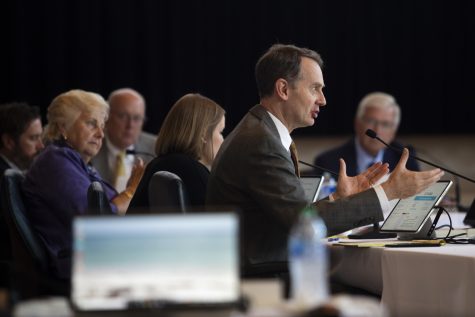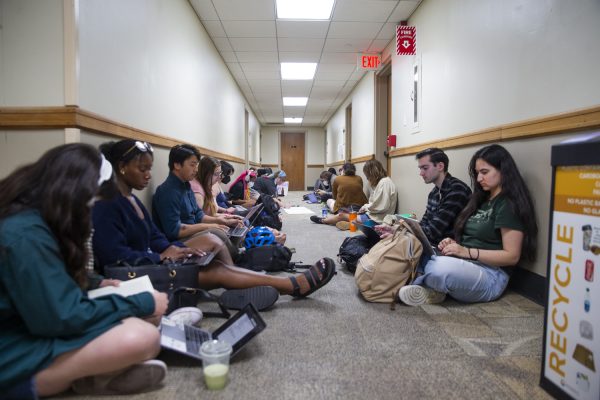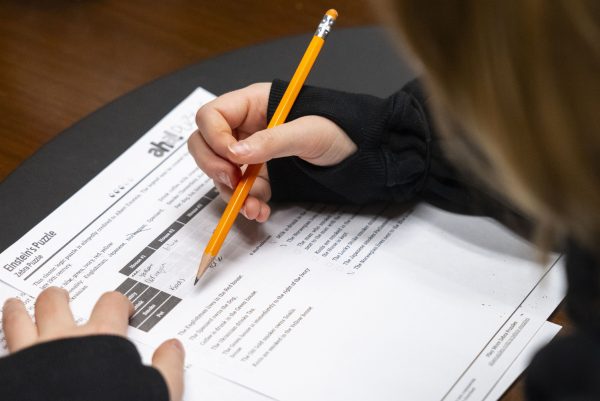Regent institutions’ total financial aid distribution drops for a third straight year
The state Board of Regents annual student financial aid report presented on Wednesday revealed that the regent institutions’ total financial aid distribution amount has dropped for a third straight year.
Regent Milt Dakovich looks at his computer at a Board of Regents meeting at the University of Northern Iowa in Cedar Falls, Iowa on Thursday, Nov. 4, 2021.
February 23, 2022
The total financial aid received by students attending Iowa’s public universities dropped for the third year in a row, decreasing from $1.06 billion in 2020 to $1.05 billion in 2021. This includes aid for both undergraduate and graduate students.
The continual drop is largely attributed to enrollment declines, the regent annual student financial aid report outlined.
“Private funding saw a slight dip last year, undoubtedly a result of the pandemic and some dips in enrollments that resulted,” said Roberta Johnson, Iowa State University director of financial aid. “The same was true for federal funding, although the downward trend since 2017 can also be attributed to the demise of the Federal Perkins Loan Program.”
Financial aid for the regent institutions comes primarily from four sources:
- Federal government (U.S. Department of Education)
- Institutional (Regent university financial aid distributed by the offices of student financial aid, academic colleges, and university foundations)
- The state of Iowa
- Other, such as private organizations, foundations, and companies
Federal financial aid for regent university students has declined over the past four years, while institutional aid from regent universities grew since last year. Institutional aid amounts jumped from $392.1 million in 2019-20 to $412.7 million in 2020-21.
The largest source of funding from the federal government is through the student loan program, Johnson said. Students also receive funding through the federal Pell Grant program.
“There are also private loans that support students for whom federal dollars are insufficient,” she said. “Each of our institutions also have funding available from private sources, which primarily include donor funding, and the remainder is made up of funding that the institutions are providing directly.”
The federal government gave out $376.3 million in aid as student loans, while the regent institutions gave out $700,000 in aid and students received $67.5 million through private scholarships.
Additionally, the report outlined that the amount of need-based grant aid awarded over the past year decreased by 1.6 percent at the UI, decreased by 3.1 percent at ISU, and increased by 2.7 percent at the University of Northern Iowa. At the UI, the amount decreased from $49.7 million in 2019-20 to $48.9 million in 2020-21.
Also highlighted was the number of students who were classified as having financial need and had that need met in the 2020-21 academic year. At the UI, the amount of resident students with financial need was 15,409. 75 percent had their financial needs met, while 9,685 non-resident students had 81 percent of their financial needs met.
The report addressed the net cost for regent institution students over the past year, which is calculated by subtracting the average amount of grants and scholarships per student from the total sticker price of attending a university.
“Net price is generally a more accurate approximation of how much a student pays for college than “sticker price,” or the official amount charged. On average, Regent university students with the greatest financial need receive the most financial aid. Since last year, the net price for students decreased for all income levels,” the report states.
Cindy Seyfer, UI assistant provost and director of student financial aid, said during the presentation that the decrease in net price is primarily attributed to an increase in institutional grants and scholarships.
“Net price can also be tied to retention and student success,” she said. “The lower the net price, the less a student either needs to borrow, or cover on their own through student employment or savings. This reduces financial stress and allows students to focus on their academics.”
Student loan debt
The presentation then highlighted student loan indebtedness, which UNI Director of Financial Aid Tim Bakula described as “relatively low.”
“If you look across the board, between 31 and 45 percent of our students, depending on the institution, do not borrow at all,” Bakula said. “This further illustrates the value of higher education within the state public university system and what students are doing to help ensure that they aren’t borrowing any more than necessary.”
The report stated that not every graduate has debt upon graduation from their institution. Among Iowa resident graduates, 42 percent from ISU, 45 percent from the UI, and 30.6 percent from UNI graduated with no debt.
Pandemic relief
The regents also reviewed the distribution of the Higher Education Emergency Relief Funds II (HEERF II) aid, which was given to students who suffered financially because of the pandemic. HEERF III will be distributed in late March and be the third and final installment of these funds available for students.
The UI distributed $8,085,677 to eligible students. While the representatives said they are excited about what HEERF II has done for students, they are also aware of what the support may mean for them in the future.
“Efforts are being taken to communicate to those students in a way that allows them to realize this financial resource has been available and it was of great use to you, however, if you need additional support, we may need to have further budgeting discussions moving into future academic years,” Bakula said.















